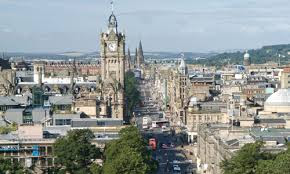The Royal Mile runs down from the Castle to Holyrood Palace
Halfway down the road is John Knox House built in 1490. It was the home to the fiery preacher, John Knox, author, reformist and founder of the Presbytarian Church which lived in the house around 1560.
Holyrood Palace and ruined Abbey are at the end of Royal Mile (as is the grotesque modern Parliament of Holyrood)
A little down the road is Surgeon's Museum. Quite facinating. I have sanitised it for you, but Paula was facinated!
Also below the castle is Grassmarket, a square with lots of activity.
It leads onto Victoria Street. I have shown two pictures - the first is looking up the street
and the second is looking down Victoria Street. What is so amazing is that there is a road above the street buildings and more buildings are perched above the upper street giving an impression of a vertical wall of buildings
The place to live in Edinburgh in the reign of Geo III was Charlotte Square. Number 7 is a Georgian house built as part of a row of houses built around the square in 1790. It is now a museum
Heading out of Edinburgh are the Royal Botanical Gardens.
A memorable visit






























